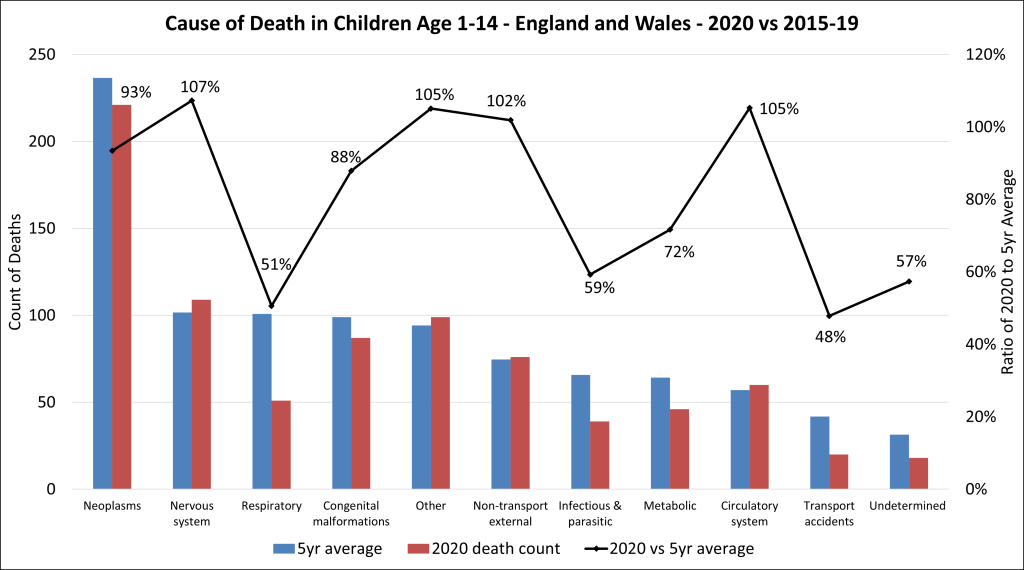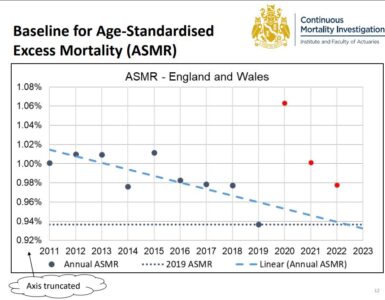Deaths within 28 days
Data available to download from the UK’s COVID Dashboard shows that in England there have been 136 deaths of children and teens within 28 days of a positive COVID test during the course of the pandemic. This number is mercifully small when compared to the overall number of COVID deaths, representing less than 0.1% of all COVID deaths. Nonetheless, it has been widely shared, prompting us to dig a little deeper into the difficult subject of COVID deaths in children.
| Age | 2020 | 2021 | 2022 | Total |
| 0-4 | 6 | 15 | 6 | 27 |
| 5-9 | 4 | 8 | 2 | 14 |
| 10-14 | 10 | 12 | 2 | 24 |
| 15-19 | 19 | 43 | 9 | 71 |
| Total | 39 | 78 | 19 | 136 |
ONS data
The first question to consider is whether COVID actually played a role in causing or accelerating these deaths. The best source to address this is ONS data where COVID was mentioned on the death certificate. The latest weekly death registrations data gives the breakdown below for England and Wales.
| Age | 2020 | 2021 | 2022 | Total |
| 0-4 | 3 | 13 | 5 | 21 |
| 5-9 | 1 | 8 | 0 | 9 |
| 10-14 | 5 | 13 | 2 | 20 |
| 15-19 | 11 | 32 | 5 | 48 |
| Total | 20 | 66 | 12 | 98 |
Comparing the two tables above we can see that:
- The number of deaths where COVID was a contributing cause is lower than the number of deaths within 28 days, despite the ONS data including Wales as well as England.
- For children aged 0-14, COVID contributed to 50 deaths in England and Wales, whereas there were 65 deaths within 28 days of a positive test in England alone.
- COVID was not incidental to most of these deaths in children, as it was a contributing cause in the majority of the deaths.
- There is a larger difference for teens aged 15-19, with COVID contributing to 48 deaths in England and Wales. This compares to 71 deaths within 28 days of a positive test in England alone.
- The number of COVID deaths in children look high in the first few weeks of 2022 relative to 2020 and 2021. Similarly, the data show that most of the deaths in 2021 happened in the second half of the year when the prevalence of COVID has been higher.
Underlying cause
While it’s clear that COVID was not completely incidental to the deaths of the majority of these children (they were not hit by a bus after testing positive) the data above does not show whether it was the underlying cause. Fortunately, another ONS data set is available which breaks down COVID deaths between those due to COVID and those involving COVID. This data is available to December 2021. This data shows that of 88 COVID deaths in children or teens, COVID was the underlying cause in 71 of them. 40 of these deaths were teens aged 15-19 and 31 were under 15s.
| Age | Deaths involving COVID | Deaths due to COVID |
| 0-4 | 14 | 8 |
| 5-9 | 9 | 8 |
| 10-14 | 18 | 15 |
| 15-19 | 47 | 40 |
| Total | 88 | 71 |
So there were 31 deaths due to COVID among children aged 0-14 in England and Wales during 2020 and 2021. This is slightly less than half of the number of deaths of children the same age within 28 days of a positive test.
Excess deaths
Deaths due to or involving COVID are only one part of the story – the pandemic has also affected other causes of death. To understand the aggregate effect we can analyse excess deaths. As we have previously discussed, excess deaths are calculated by comparing actual mortality to a reference amount or benchmark.
Among children aged 1-14 there were around 970 deaths each year on average in England and Wales between 2015 and 2019. The worst year was 2015 with 1,028 deaths and the best was 2019 with 934 deaths.
Both 2020 and 2021 had significantly fewer child deaths, with around 820 each year. That is a reduction in child deaths of around 15%. That is despite an increase in the number of children aged 1-14 from 9.6 million in 2015 to 10.1 million in 2020.
We have excluded deaths of infants under one year of age as these are mostly still births and neonatal mortality. Although these rates are low by historical standards there are sadly still around 2,500 each year, which is much higher than all other deaths in children combined.
Cause of death analysis
We’ve analysed the 21st Century Mortality dataset provided by ONS. This has details of death registrations in England and Wales, broken down by age and cause, as far as 2020. The cause here is the one listed on death certificates as the underlying cause.
As noted above, deaths were down by 15% overall for children aged 1-14. Here is an overview of the biggest reductions by cause:
- Deaths from respiratory diseases were at around half their normal level, meaning around 50 fewer deaths. This category is mostly deaths from pneumonia, asthma and influenza. The benefit is likely to have arisen from measures implemented to limit the spread of COVID having a significant impact on other viruses.
- Infectious and parasitic diseases were down by 40%, meaning around 25 fewer deaths than normal. This category is mostly deaths from sepsis and meningitis. Again, it is likely that the benefit arose from bacterial infections being suppressed by measures taken to control COVID.
- Transport accidents were at around half their normal level. That’s around 20 fewer deaths and is likely to be a consequence of reduced mobility during 2020.
- Endocrine, nutritional and metabolic deaths were down by around 30%. That’s around 20 fewer deaths. Since these deaths are mostly from metabolic disorders it is plausible that the reduction in deaths arose from parents having more control over the food and drink consumed by their children when movement was more restricted in 2020.

COVID was a factor in around 2% of deaths in children aged 1-14 in 2020 and 2021. The deaths were spread unevenly, mostly happening around the first and second peaks, and in the second half of 2021 following “Freedom Day“.
Other risks
There are of course arguments other than risk of death for preventing or reducing the circulation of the virus in children. The longer term health consequences of infection are unknown, and include the risk of long COVID. There is the risk of disruption to education and the risk that they pass the virus to higher risk groups. These arguments should be judged on their own merits. For now we have consciously limited the scope of this blog to consideration of the risk of death.
Conclusions
COVID caused the deaths of 31 children under age 15 in England and Wales in 2020 and 2021. It was also a factor involved in another 10 deaths among the same age group. Most of those deaths were in the second half of 2021 when prevalence of COVID was high.
Overall deaths for children aged 1-14 were much lower than normal – down by 15%.
Analysis of deaths in 2020 shows that the biggest falls were in respiratory and infectious diseases, which are typically caused by viruses or bacterial infections.
The number of COVID deaths among children was small relative to the reduction in deaths from other respiratory and infectious diseases. That suggests that many of the children whose deaths involved COVID were clinically vulnerable. In pre-pandemic years they might have been at risk of death from normal circulating infections. However, we can’t be completely confident in this conclusion without more granular data.
Obviously that doesn’t mean that these deaths matter any less and this does give pause for thought about how these deaths might be prevented or delayed. It does however suggest that if a child is at risk of death from COVID then the parents are probably already aware.
This analysis shows that the mortality risk posed to children by COVID looks comparable to the risk from other viruses. It also raises broader questions about prevention of death relating to infections and the practicality of measures required to achieve this.
More or Less
Stuart discussed this analysis with Tim Harford on BBC More or Less on 16 February. You can listen to the show here.















